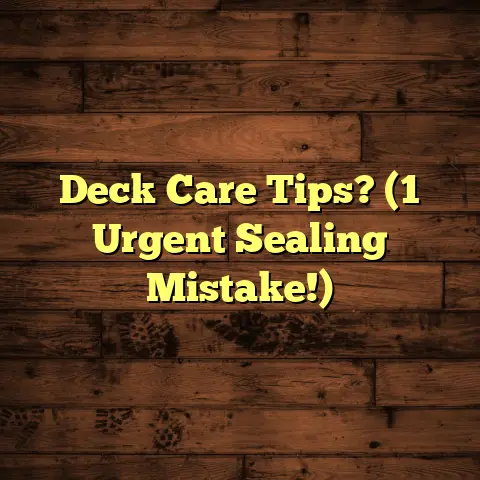Epoxy Over Epoxy Floors? (1 Cure You Need!)
Have you ever looked at your old epoxy floor and wondered if you could just slap a new layer on top?
Like, no fuss, no muss, just a fresh coat of shine?
I get it.
It’s tempting!
But is it really that simple?
Let’s dive deep and find out.
1. Understanding Epoxy Flooring
Let’s start with the basics. What is epoxy flooring, anyway?
Definition and Composition
Epoxy flooring isn’t just paint.
It’s a thermosetting polymer formed by mixing a resin and a hardener.
When these two components combine, a chemical reaction occurs, creating a rigid, durable plastic material.
Think of it as liquid plastic that hardens into a super-tough surface.
The specific types of resins and hardeners vary, and that’s important!
Different formulations offer different properties like chemical resistance, flexibility, or cure times.
Benefits of Epoxy Floors
Why do people even bother with epoxy? Well, the benefits are pretty compelling:
- Durability: Epoxy floors can withstand a beating.
They’re resistant to impacts, abrasions, and heavy loads. - Resistance to Stains: Oil, grease, chemicals – epoxy shrugs most of them off.
- Ease of Maintenance: A simple mop and some mild detergent usually does the trick.
- Aesthetic Appeal: You can get epoxy in a huge range of colors, patterns, and finishes.
Metallic epoxy floors are super popular now! - Cost-Effectiveness: While the initial investment might seem higher than some other flooring options, the longevity and low maintenance often make it cheaper in the long run.
Common Applications
You’ll find epoxy flooring in a ton of places:
- Residential Garages: This is where most people first encounter epoxy.
- Commercial Spaces: Retail stores, showrooms, and restaurants often use epoxy for its durability and looks.
- Industrial Facilities: Factories, warehouses, and manufacturing plants rely on epoxy’s ability to withstand heavy use and chemical spills.
- Hospitals and Labs: Epoxy’s seamless surface makes it easy to sterilize and maintain a hygienic environment.
2. The Lifecycle of an Epoxy Floor
Epoxy isn’t a “set it and forget it” solution. It has a lifecycle.
Installation Process
Here’s a simplified breakdown of how I install epoxy floors:
- Surface Preparation: This is crucial.
I’m talking grinding, shot blasting, or acid etching to create a profile for the epoxy to grip. - Cleaning: Removing all dust, debris, and contaminants.
- Priming (Optional but Recommended): This helps the epoxy bond even better.
- Mixing: Precisely measuring and mixing the resin and hardener.
- Application: Pouring and spreading the epoxy evenly.
- Curing: Letting the epoxy harden according to the manufacturer’s instructions.
Longevity and Wear
A well-installed epoxy floor can last for years – even decades!
But several factors affect its lifespan:
- Traffic: Heavy foot traffic or forklifts will wear down the surface faster.
- Chemical Exposure: Harsh chemicals can damage the epoxy over time.
- UV Exposure: Sunlight can cause discoloration and fading.
- Installation Quality: A poorly prepped surface or incorrect mixing will lead to premature failure.
Signs of Deterioration
Keep an eye out for these signs that your epoxy floor might need some attention:
- Peeling: The epoxy is lifting away from the substrate.
- Cracking: Cracks can be caused by impacts, substrate movement, or improper installation.
- Discoloration: Fading or yellowing due to UV exposure or chemical spills.
- Chipping: Small pieces of epoxy breaking off.
- Loss of Sheen: The floor looks dull and worn.
3. The Concept of Layering Epoxy
So, can you just layer new epoxy over old epoxy? Let’s break it down.
Why Layer Over Existing Epoxy?
People consider layering for a few reasons:
- Aesthetic Updates: Maybe you want a new color or decorative finish.
- Damage Repair: To cover up cracks, chips, or stains.
- Extending Lifespan: To add a fresh protective layer.
- Cost Savings: It seems cheaper than a full removal and replacement.
Compatibility Considerations
Here’s the catch: not all epoxies are created equal.
- Chemical Compatibility: The new epoxy needs to be compatible with the old epoxy.
If they aren’t, you could end up with adhesion problems, bubbling, or even a chemical reaction that degrades the floor. - Surface Contamination: Any dirt, grease, or contaminants on the old epoxy surface will prevent the new epoxy from bonding properly.
- Existing Damage: Cracks or peeling in the old epoxy will telegraph through the new layer.
4. The One Cure You Need
Okay, so layering epoxy can be done, but only if you do it right.
And that starts with the “one cure” I promised you.
Introduction to the Cure
That “one cure” isn’t a magic potion. It’s proper surface preparation!
Without proper surface preparation, you’re basically building a house on sand.
The new epoxy won’t bond properly, and you’ll end up with a bigger mess than you started with.
Detailed Explanation
Here’s my step-by-step guide to preparing an existing epoxy surface for a new layer:
- Cleaning: Start with a thorough cleaning.
Use a degreaser to remove any oil, grease, or dirt.
Rinse well and let the floor dry completely. - Inspection: Carefully inspect the floor for any damage like cracks, chips, or peeling.
Address these issues before moving on. - Repairing Damage:
- Cracks: Fill cracks with an epoxy crack filler.
- Chips: Patch chips with an epoxy patching compound.
- Peeling: Scrape away any loose or peeling epoxy.
You might need a floor scraper for this.
- Sanding/Grinding: This is the most important step!
You need to create a profile – a rough surface – for the new epoxy to grip.- Sanding: Use a coarse-grit sandpaper (60-80 grit) to sand the entire surface.
- Grinding: For larger areas or tougher surfaces, a floor grinder with a diamond grinding pad is ideal.
- Vacuuming: Thoroughly vacuum up all the dust and debris created by sanding or grinding.
- Solvent Wipe: Wipe the floor with a solvent like isopropyl alcohol or acetone to remove any remaining contaminants.
- Tack Cloth: Use a tack cloth to pick up any final dust particles.
Recommended Products
Here are a few products I recommend for surface preparation:
- Degreaser: Simple Green Industrial Cleaner & Degreaser
- Epoxy Crack Filler: PC-Concrete Two Part Epoxy Crack Repair
- Epoxy Patching Compound: 3M Scotch-Weld Epoxy Adhesive DP100
- Primer/Bonding Agent (Optional but Highly Recommended):
- Epoxy Primer: A primer specifically designed for epoxy flooring, like the UCoat It Epoxy Primer.
- Bonding Agent: A bonding agent like West System G/flex 655 Epoxy can improve adhesion, especially on smooth surfaces.
Safety First! Always wear appropriate safety gear, including gloves, eye protection, and a respirator, when working with epoxy and solvents.
5. Application Process
Now that your surface is prepped, let’s talk about applying the new epoxy.
Step-by-Step Application
- Mixing: Carefully measure and mix the resin and hardener according to the manufacturer’s instructions.
Use a drill with a mixing paddle for best results. - Pouring: Pour the mixed epoxy onto the floor in ribbons.
- Spreading: Use a squeegee or notched trowel to spread the epoxy evenly.
- Back Rolling: Use a spiked roller to remove any air bubbles.
- Decorative Flakes/Additives (Optional): If you’re adding flakes, glitter, or other decorative elements, broadcast them evenly over the wet epoxy.
- Curing: Let the epoxy cure according to the manufacturer’s instructions.
This can take anywhere from 24 to 72 hours, depending on the product and temperature. - Topcoat (Optional): Apply a clear topcoat for added protection and shine.
Common Mistakes to Avoid
- Skipping Surface Preparation: This is the biggest mistake! Don’t even think about skipping it.
- Improper Mixing: Not mixing the resin and hardener thoroughly can lead to soft spots or uncured areas.
- Applying Too Thick: Applying the epoxy too thick can cause bubbles or cracking.
- Applying in Humid Conditions: High humidity can affect the curing process and lead to a cloudy finish.
- Not Following Manufacturer’s Instructions: Always read and follow the manufacturer’s instructions for the specific epoxy you’re using.
6. Maintenance and Care
You’ve got a beautiful new epoxy floor! Now, let’s keep it that way.
Post-Installation Care
- Avoid Heavy Traffic: Keep heavy traffic off the floor for at least 24 hours after installation.
- No Chemical Exposure: Avoid exposing the floor to harsh chemicals for at least 7 days.
- Protect from Scratches: Use mats or rugs in high-traffic areas to protect the floor from scratches.
Regular Maintenance Tips
- Sweep Regularly: Sweep the floor regularly to remove dirt and debris.
- Mop with Mild Detergent: Mop the floor with a mild detergent and water.
Avoid using harsh chemicals or abrasive cleaners. - Spot Clean Spills: Clean up spills immediately to prevent staining.
- Use Floor Mats: Place floor mats at entrances to trap dirt and debris.
- Consider a Maintenance Coat: After a few years, consider applying a maintenance coat of epoxy to refresh the floor and extend its lifespan.
Conclusion
Layering epoxy over existing epoxy floors can be done successfully, but it requires careful planning and execution.
The “one cure” – proper surface preparation – is absolutely essential.
By following my steps and avoiding common mistakes, you can achieve a beautiful, durable epoxy floor that will last for years to come.
Don’t cut corners, do your research, and remember, a little extra effort upfront will save you a lot of headaches down the road!




